#Five-banded Thynnid Wasp
Text

Five-banded Thynnid Wasp (Myzinum quinquecinctum)
It is unfortunate that many people lump all wasps together as being bad for fear of being stung. The female Five-banded Thynnid Wasp has the ability to sting but uses her stinger to disable beetle larvae, specifically those in the Family Scarabaeidae, which includes pests like the Japanese beetle, European chafer and rose chafer. The female wasp looks for these beetles in their grub stage when she can paralyze them with her stinger and deposit her eggs on them. The wasp larvae hatch and attach themselves to the beetle larvae which they gradually consume before entering their cocoon. After spending the winter in the soil the adult wasp emerges the following year.
23 notes
·
View notes
Text

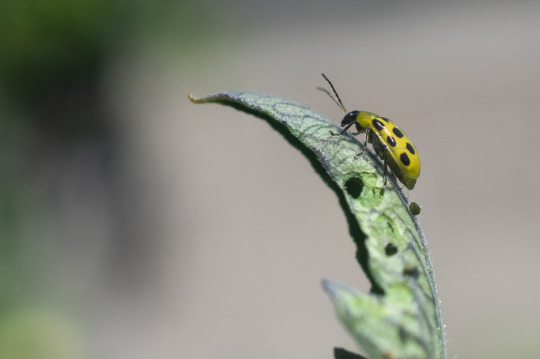

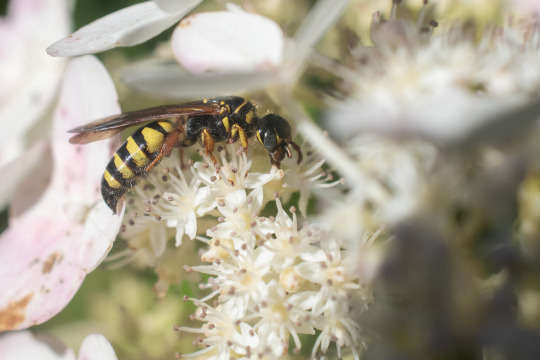
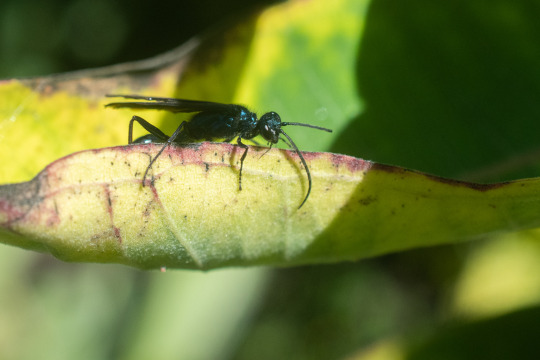


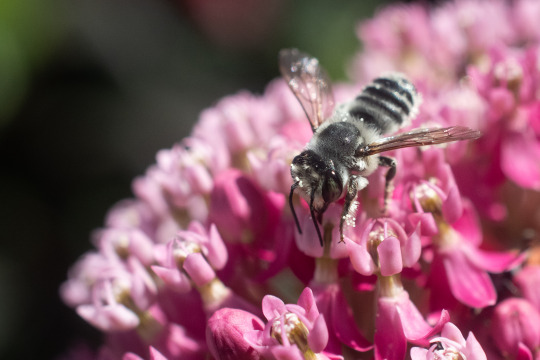





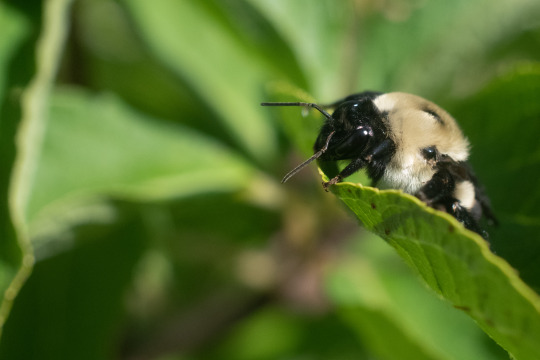
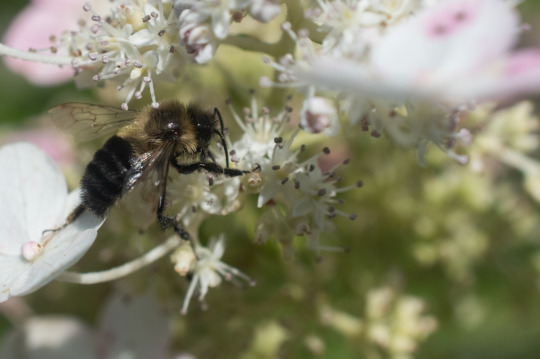
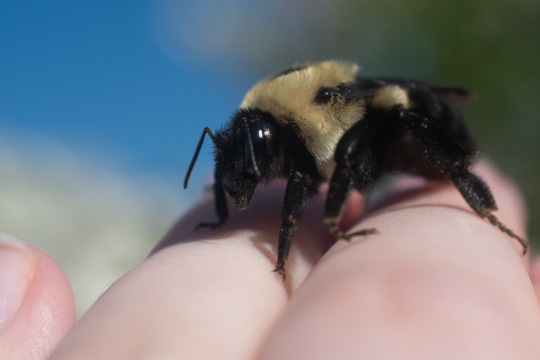


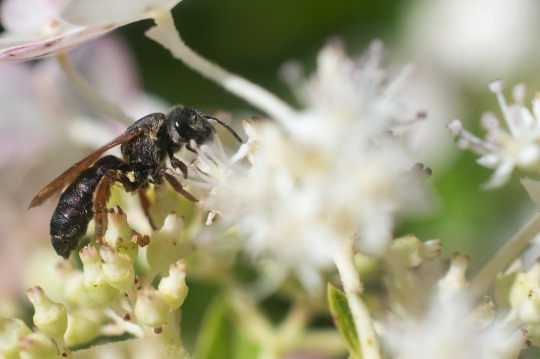

European Paper Wasp (Polistes dominula) ♂
Spotted Cucumber Beetle (Diabrotica undecimpunctata)
Great Golden Digger Wasp (Sphex ichneumoneus)
Five-banded Thynnid Wasp (Myzinum quinquecinctum)
Common Blue Mud-dauber Wasp (Chalybion californicum)
Chrysidini sp.
Four-banded Stink Bug Wasp (Bicyrtes quadrifasciatus)
Megachile sp.
Parallel-striped Sweat Bee (Halictus parallelus)
Myzinum maculatum ♀
Archytas apicifer?
Goldenrod Soldier Beetle (Chauliognathus pensylvanicus)
Archytas apicifer?
Common Eastern Bumble Bee (Bombus impatiens) ♀
Common Eastern Bumble Bee (Bombus impatiens) ♂
Common Eastern Bumble Bee (Bombus impatiens) ♀
Lobed Mason Wasp (Ancistrocerus antilope)
Narrow-headed Marsh Fly (Helophilus fasciatus)
Hawthorn Mining Bee (Andrena crataegi)?
Vespula Sp.
Foaming at the mouth at the absolute biodiversity in my yard this year! We have this bush in the yard that the wasps, bees and flies are obsessed with, which is where I took most of the pictures.
I also noticed these HUGE flies which I've never seen before. Usually if you even look in the general direction of a fly it immediately takes off but these ones could not care less, I could put my hand right up to them and they didn't move until I physically touched them.
Also once again completely baffled by the people who talk about how "aggressive" and "mean" wasps are and how they constantly get stung. What are you guys doing??? None of the above species gave a single shit about me shoving my macro lens in their faces, and if it was windy I would sometimes grab the branch they were on to hold it steady and none of them even reacted.
The queen bee (which has a stinger unlike the males) also made no effort to sting me, after picking her up for a photo she actually refused to get off of my hand because she wanted to sit on me and groom her face.
We've also had lots of yellowjackets (I'm so bad at IDing them so no idea on species) approaching us recently and checking us out, flying extremely close and looking at us and then flying away. Even if I put my hand up in front of them to see if they want to land they sort of just look at it and then fly away.
Last year there were paper wasps on nests in my yard and they would stare at me warily but never sting me when I photographed them.
Also feel free to ID things on my iNaturalist or correct me on any IDs here!
#Long Post#Not Pets#Wildlife Photography#Invertebrates#European Paper Wasp#Spotted Cucumber Beetle#Great Golden Digger Wasp#Five-banded Thynnid Wasp#Common Blue Mud-dauber Wasp#Four-banded Stink Bug Wasp#Parallel-striped Sweat Bee#Goldenrod Soldier Beetle#Common Eastern Bumble Bee#Lobed Mason Wasp#Narrow-headed Marsh Fly#Hawthorn Mining Bee#Yellowjacket
1 note
·
View note
Text

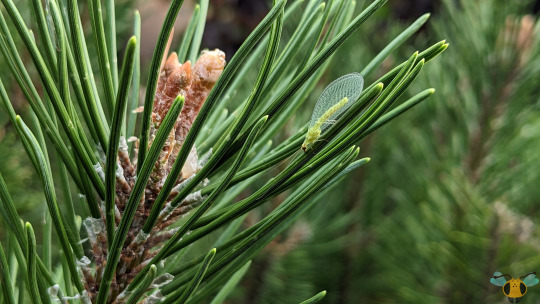

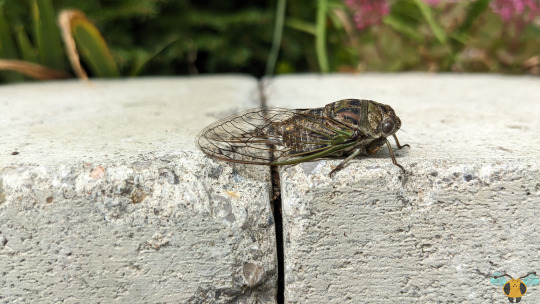
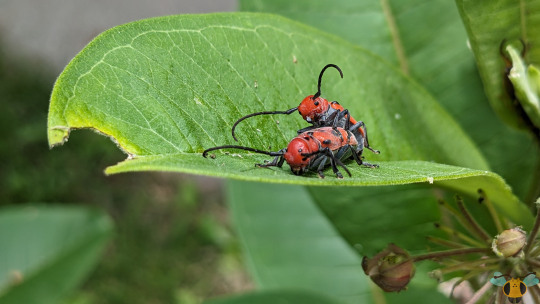
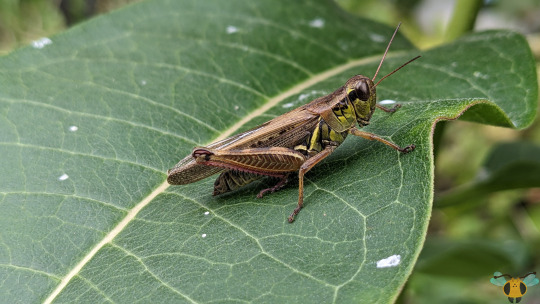
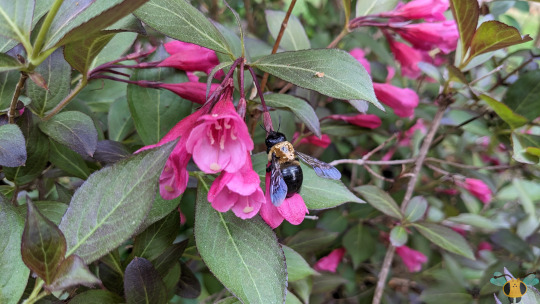
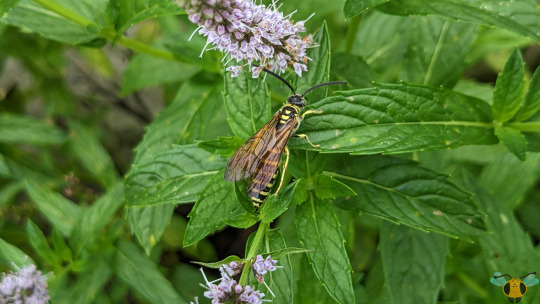
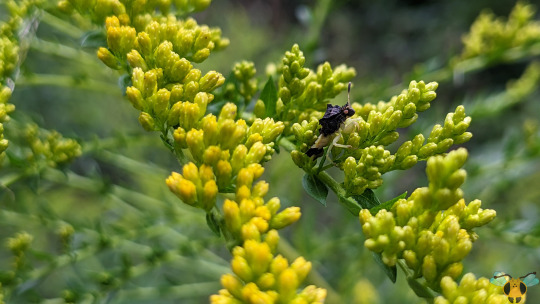
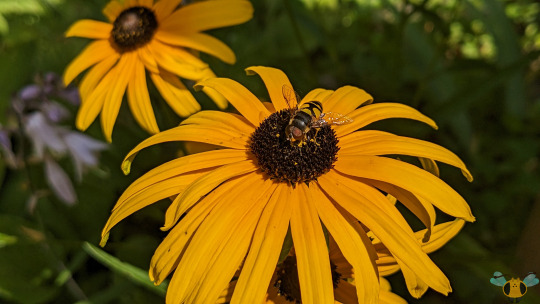
Insect Highlights of 2023
With the new year celebrations scheduled for this weekend, I thought it best to share some of my favorite insect specimens from this year, rather than one single typed of insect. The pictures here haven't been uploaded to the blog in a post, so today they can all share the spotlight. There are many familiar faces here and all of them are incredible and beautiful creatures. Hopefully there are even more insect delights and finds to enjoy in the upcoming year. To ring in the new year, we have the following insects:
Monarch Butterfly - Danaus plexippus - Order Lepidoptera (August 7th)
Green “Goldeneye” Lacewing - Chrysopa oculata - Order Neuroptera (July 26th)
Carolina Locust - Dissosteria carolina - Order Orthoptera (August 20th)
Dog-Day Cicada - Phymata pennsylvanica - Order Hemiptera (August 24th)
Milkweed Beetle - Tetraopes tetrophthalmus - Order Coleoptera (July 9th)
Red-Legged Grasshopper - Melanopus femurrubrum - Order Orthoptera (September 13th)
Eastern Carpenter Bee - Xylocopa virginica - Order Hymenoptera (June 5th)
Five-Banded Thynnid Wasp - Myzinum quinquecinctum - Order Hymenoptera (August 7th)
Jagged Ambush Bug - Phymata pennsylvanica - Order Hemiptera (August 20th)
Transverse Hoverfly - Eristalis transversa - Order Diptera (August 8th)
All pictures here were taken in 2023 with a Google Pixel 4.
Wishing everyone a very Happy New Year and a great 2024! And thank you everyone for making this a wonderful year of insects!
#jonny’s insect catalogue#ontario insect#beetle#butterfly#cicada#grasshopper#lacewing#fly#wasp#true bug#monarch butterfly#eastern carpenter bee#dog day cicada#five banded thynnid wasp#green lacewing#jagged ambush bug#transverse hoverfly#red legged grasshopper#carolina locust#milkweed beetle#2023#toronto#june2023#july2023#august2023#september2023#happy new year#happy new year 2024#nature#entomology
4 notes
·
View notes
Text
Beautiful Pink Tamarisk Flowers are Loved by Fall Pollinators
Beautiful Pink Tamarisk Flowers are Loved by Fall Pollinators features a five banded thynnid wasp in some tamarisk flowers. It explains why the author/artist likes these wasps so much.
Thynnid in the Tamarisk
When I went hiking last weekend I found a huge patch of tamarisk flowers (Tamarix sp.) that were filled with all sorts of fall pollinators. I probably could have stayed there all afternoon because every time I was ready to go, I’d spot another bee or wasp that I hadn’t photographed yet. One of my favorite wasps there were the little five banded thynnid wasps (Myzinum…

View On WordPress
#beautiful wasps#black and yellow wasps#colorful wasps#docile wasps#fall wasps#five banded thynnid wasp#Florida thynnid wasps#Florida wasps#macro photographs#macro photography#small wasps#thynnid wasp photographs#thynnid wasps#thynnid wasps in tamarisk#wasp photographs#wasp photography#wasps#wasps on flowers
0 notes
Text
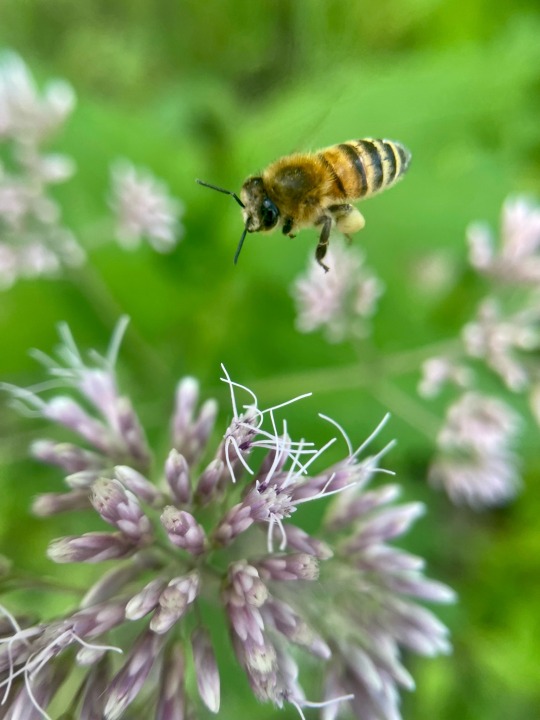

Western Honey Bee (Apis mellifera)
Five-banded Thynnid Wasp (Myzinum quinquecinctum)
48 notes
·
View notes
Note
almost forgot bug of the day
bug of the day!!!!
five-banded thynnid wasp!!
hey i know these guys, i hate them so so so much
#i hate wasps#theyre necessary but i have a crippling fear of all loud bugs#ask#asks#🪲 anon#bug of the day
1 note
·
View note
Photo


Five-banded Thynnid Wasp (Myzinum quinquecinctum)
September 3, 2021
Southeastern Pennsylvania
#bug#bugs#photographers on tumblr#Five-banded Thynnid Wasp#Myzinum quinquecinctum#wasp#wasps#insect#insects#bugblr#entomology
201 notes
·
View notes
Text

January 15th, 2019
The insect of the day is the Five-Banded Thynnid Wasp !
6 notes
·
View notes
Photo

Five-banded Thynnid Wasp (Myzinum quinquecinctum)
August 14, 2013
0 notes
Photo








Sculptured Resin Bee - Megachile sculpturalis
A tip for when you bug hunt around your neighborhood: take note of the areas where insects tend to gather, particularly if the areas are home to specific or “more unique” insects. There may be something significant about that area that is advantageous for those insects to gather there, and thusly it’s very likely that you might see those insects again there, depending on the time of year, the weather and even surrounding plants. This information can help when creating your own insect habitats and bring in insects you wish to see in your area. It’s also a good way to measure consistency year after year: if the insects don’t return and stay away, it’s wise to think on what has changed. There are specific sites in my area where specific insects gather in populous amounts due to the area’s conditions. One particular bed of flowers in the neighborhood brings Five-Banded Thynnid Wasps in the summer; the goldenrod flowers near the creek’s black locust trees always bring Locust Borers near the end of summer; and one particular bed of flowers seems to be alluring to this particularly large Leafcutting Bee. I’m super happy (and lucky) to have seen them again and I’ll be checking in on the flower bed again next year between mid July to mid August to see if they return then (though Bugguide has observed them active from June to September). I’ve got to work on getting the timing just right!
Of course other pollinators, social Bees in particular, also frequent these flowers, so there’s always an opportunity for some photography and to observe the behaviors and habits of our Bee friends. If I find the Sculptured Resin Bees here again next year, perhaps it may be possible to track and find one to its nest. Aside from feeding themselves, pollen needs to be gathered for the young Bee larvae which will be a provision for them until the next year (they overwinter inside a hollow cavity) nest. Even if that’s not the case here, perhaps following these Bees may lead me to the flowers they obtain pollen from; the flowers here seem to be solely providing nectar to the feeding males. Perhaps female Resin Bees are found elsewhere on flowers more suitable to their needs? I suppose I’ve have to expand my area of search to see what I can find. In any case, if you by chance discover one of these Bees, you can tell males and females apart by markings on their face and the shape of their abdomen. Females have no patches on their face and an abdomen that tapers to a point. Males have facial patches and a blocky abdomen, and since they lack a stinger are safe to handle. Having said that, since their jaws are designed to scrape resin and sap from trees, best not to pester them or prod their face.
Pictures were taken on July 30, 2022 with a Google Pixel 4.
#jonny’s insect catalogue#ontario insect#bee#sculptured resin bee#leafcutting bee#hymenoptera#insect#toronto#july2022#2022#entomology#nature#invertebrates#arthropods
13 notes
·
View notes
Photo










European Paper Wasp - Polistes dominula
Take good note of those warning stripes of black and yellow! They are a big and bright sign that says, “stay away please”. The workers of the paper colony are hard at work gathering food for themselves and the young larvae in the nest’s hexagonal cells, and they (the adults) don’t like to be disturbed as they fly around the gardens, neighborhoods and wilderness. It’s wise to not bother them and give them room to fly around, though from my experience they are more likely to flee away to another plant than buzz around a curious photographer. Calling back to the first post with these Wasps, they (to me) don’t seem as aggressive as other colony Wasps such as the similar looking Yellowjackets. Compared to that first post, there are a lot more closeups, fun angles and Wasps in odd places and hiding spots compared to last time, allowing us to take a deeper look at their habits and how they interact with their environment.
As mentioned earlier, though similar in appearance to Yellowjackets, you can tell these Paper Wasps apart from them by looking at their wings (at rest), their legs and antennae. The wings rest differently and are orange-tinted, as are the legs and antennae. When in flight the rear legs dangle, while Yellowjackets tuck their legs in while flying. As well, something I didn’t notice until looking at these images more closely is that the European Paper Wasp’s mandibles are black-colored and are reduced (almost beak like) compared to the Yellowjacket’s large serrated yellow mandibles. See for yourself. To be fair, the mandibles are hard to see directly when your focus drifts to the Wasp’s face and its abdominal stripes. Though it’s ok to feel scared by Wasps, we don’t have to demonize them and we can treat them as our insect friends, especially given they are very handy at eating pest species and helping to pollinate flowers. Let them have their airspace and you’ll discover many things of your own about them. If you get somewhat close, you should also keep this in mind: female European Paper Wasps tend to have straight antennae and shorter, wider abdomens than males (the latter’s antennae are usually hooked). You’ll really need to look closely...it’s not like looking at the Five-Banded Thynnid Wasp, which are much easier to tell apart.
Update (April 18, 2023): It’s come to my attention that this post came up just after the passing of renowned entomologist Justin Schmidt, creator of the Schmidt pain index and investigator of the mysteries of insects. May he rest in peace. This post’s timing was purely coincidental. If you seek more information regarding Dr. Schmidt on this blog, I refer you to a Wasp-Mimic post and my coverage on his 2016 book, The Sting of the Wild. Otherwise, I recommend you seek out his insect research literature or his many stories on insect stings.
Pictures were taken on May 31; June 6, 7 and 25; July 5, 10 and 28; and August 18, 2020 with a Google Pixel 4. I proclaim this: The Summer of Wasps
#jonny’s insect catalogue#ontario insect#wasp#European paper wasp#paper wasp#hymenoptera#insect#toronto#2020#may2020#june2020#july2020#august2020#entomology#nature#invertebrates#arthropods
1 note
·
View note
Photo










Five-Banded Thynnid Wasp - Myzinum quinquecinctum
Next week I’ll be showcasing some morphological differences between male and female insects across a handful of orders. Just a small showcase but these differences are very handy to know. They’ll help your identification and also allow you to make behavioral predictions and possibly even allow you to determine what other insects are nearby based on their habits. To begin, we fulfill a promise from an earlier post to showcase the opposite gender of the Five-Banded Thynnid Wasp. The previous post showcased the males of the specie congregating on flowers in search for food (and possibly mates). No females were found during that observation, but nearly a year later on a second visit, I’ve found and observed several female individuals (but no males this time, hmmm) searching for food in the flowers. Like their male counterparts, they tolerate their fellow flower-loving insects, even the Beewolves. As the differences between males and females were highlighted in the earlier post, I’ll brief here. You might want to keep the 2 posts side by side to compare between the two and highlight their differences.
Female Five-Banded Thynnid Wasps have shortened, red-orange colored antennae (think European Paper Wasps vs. Yellowjacket), are more robustly built, lack a pseudostinger and have a real stinger. With a real stinger, they might sting you if disturbed, but fortunately don’t have nest to guard so there’s little danger of a swarm coming over a disturbance. Nevertheless, better to respect their space and observe with caution; they’re just trying to feed and be vigilant for threats. They may resemble Yellowjackets but they lack the aggressive behavior Yellowjackets are known for. While their stinger is handy for defense. it is primarily their tool for paralyzing Beetle grubs so that their offspring will have a food source when they hatch. While they search for prey in a matter similar to Digger Wasps by investigating the soil, who also look for plump insect prey to paralyze, these Wasps apparently sting the target, lay the egg and then leave the prey alone rather than haul it away to burrow. Sounds strange, but the strategy seems to work so there is little cause for alarm. There is a particular garden where they appear so its likely well protected from Japanese Beetles (Scarab Beetle larvae are the primary food source). Wish these Wasps would come to visit our yards, but likely we don’t have the flowers they prefer.
*Note: Another difference between males and females of this specie is that they have brown and orange tinted wings respectively. However, in my own observations this can be quite variable, especially when the insect is in motion. Better to refer to the more distinct features such as antennae and abdominal protrusions or lack thereof.
Pictures were taken on August 10, 2020 with a Google Pixel 4.
#jonny’s insect catalogue#insect#wasp#five banded thynnid wasp#hymenoptera#toronto#2020#august2020#ontario insect#entomology#nature#invertebrates#arthropods
1 note
·
View note
Text
Thynnid Wasps Love Habitats with Colorful Wildflowers
Thynnid Wasps Love Habitats with Colorful Wildflowers shows readers an artistically rendered photo of a five banded thynnid wasp with parts of it’s body replaced by a photo of it’s habitat. It also explains why the author/artists chose this image.
Thynnid Wasp Habitat
Thynnid wasps (Myzinum quinquecinctum) tend to be very gentle wasps that feed on the pollen and nectar of wildflowers. They’re one of my favorites even though they are shy and can be bothered by my attentions when I’m photographing them. I like their bold black and yellow coloration. For tonight’s image I decided to get kind of artsy and replaced parts the wasp’s body with…
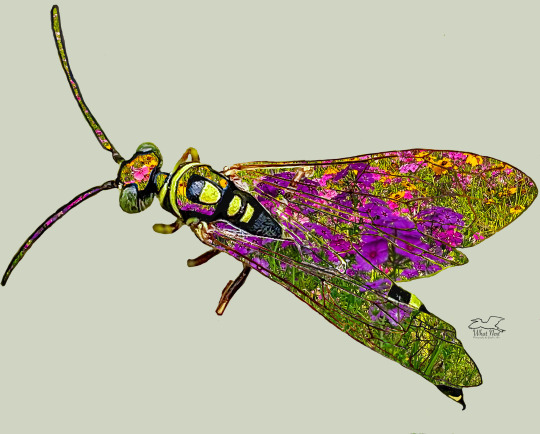
View On WordPress
#artistic photography#bees and wasps#colorful wasps#colorful wildflowers#five banded thynnid wasp#Florida habitats#Florida wasps#habitats#photography#thynnid wasps#wasps#wildflowers
0 notes
Text
Winged Sumac is Great for Attracting Pollinators
Winged Sumac is Great for Attracting Pollinators shows readers several types of pollinators that can be found feeding on the now flowering winged sumac plant. This plant only blooms for a few weeks, but it’s very important to these insects.
Thynnid and Sumac
Great Black Wasp and Sumac
Fall must be around the corner. The fall wildflowers are starting to appear and several of them provide a lot of nutrition to the fall pollinators. Probably the most important one is the blackjack flower (Bidens pilosa) simply because it lasts much of the fall until the first freeze. Those are just beginning to bloom and will not be at their peak for…

View On WordPress
#black dotted spragueia moth#double banded scoliid wasp#five banded thynnid wasp#Florida insects#Florida moths#Florida wasps#flying insects#great black wasp#insects#moths#narrow waisted wasps#pillinators#spragueia moth#sumac#wasps#Winged sumac#winged sumac flowers
0 notes
Text
The Beautiful Five Banded Thynnid Wasp is Great for Gardens!
The Beautiful Five Banded Thynnid Wasp is Great for Gardens! gives readers some basic information about these interesting insects and explains why they are so helpful in gardens. It also discusses the author’s first encounter with them on a nature walk.
Thynnid Wasp
One of the things that we don’t lack for down here in Florida are wasps. Fortunately, most of our wasps are nonaggressive and usually don’t sting or bother people unless provoked. I have already introduced you to a few of those including the common paper wasp and the organ pipe wasp. Not long ago when I was on one of my walks on the state forest land by my house I came on this bush…
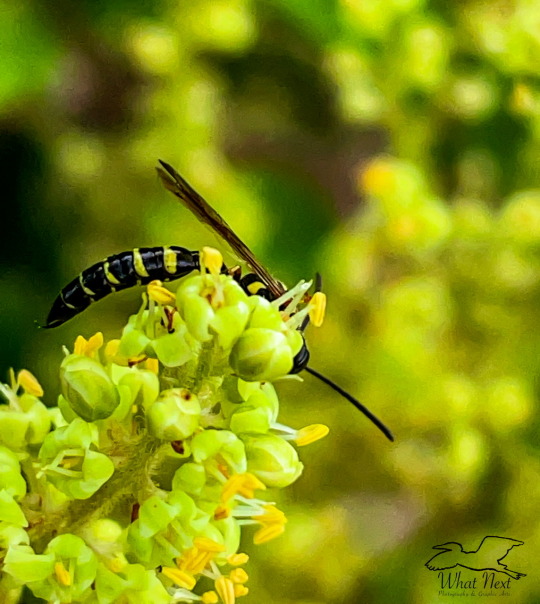
View On WordPress
#five banded thynnid wasp#gardens#nature#nature photographs#pollinators#thynnid wasps#wasps#wildlife#wildlife photographs
0 notes
Photo










Five-Banded Thynnid Wasp - Myzinum quinquecinctum
This peculiar Wasp might just have the most quirky combination of scientific names for its genus and species. It’s nothing out of the ordinary, making reference to the yellow bands on its abdomen, but still, doesn’t exactly roll off the tongue smoothly. In any case, as part of my new goal for the blog following one year of activity, I’m adding as many new species as I can to showcase them. This particular insect specie is a Thynnidae Wasp, more commonly known as a Flower Wasp (though that’s really not saying much, most Wasps enjoy flowers) and in these images many individuals are showcased searching for nectar in these tiny flowers, minding each others space. They also had to share the flowers with Honeybees and Beewolf Wasps too, but everything was peaceful.
Apparently, when it comes to Thynnids like these, while usually solitary, males will gather on plants (though a bit more organized than this) in large groups to rest together and to throw themselves to the selection of female Wasps. It may not be clear at first glance, but the individuals showcased here are in fact male Thynnid Wasps, even though they look particularly menacing with their large size and that “stinger” at the end of their abdomen. Had I known these were males, I’d have gotten much closer to them during the observation but the aforementioned features made me a bit nervous. It was only after the fact I learned that curved hook is a pseudostinger and is not used to defend itself, and what the distinctions between male and females wasps actually were.
Compared to males, female FBTWs are smaller, thinner and have antennae, wings and legs that are more orange in color. Females also trade the abdominal curved hook for a real stinger which they CAN use to defend themselves and lay eggs. Unlike Digger Wasps which haul prey to their dens, these Wasps’ egg-laying habits have more in common with Tachinid Flies, who lay their eggs directly on a host. When the eggs hatch, the larvae burrow into their host and eat them alive. FBTWs have an inclination towards a Scarab Beetle Larva when it comes to choosing a host for their eggs, which means the young of Japanese Beetles and May Beetles are at great risk of predation. While its sad to see Beetles being devoured so young, these Wasps do help control pests that love to munch on leaves and flower petals so if you’re a gardener, consider yourself lucky to have these vigilantes guarding your plants.
Pictures were taken on August 16, 2019 with a Samsung Galaxy S4
#jonny’s insect catalogue#insect#wasp#five banded thynnid wasp#hymenoptera#toronto#august2019#2019#ontario insect#entomology#nature#invertebrates#arthropods
0 notes